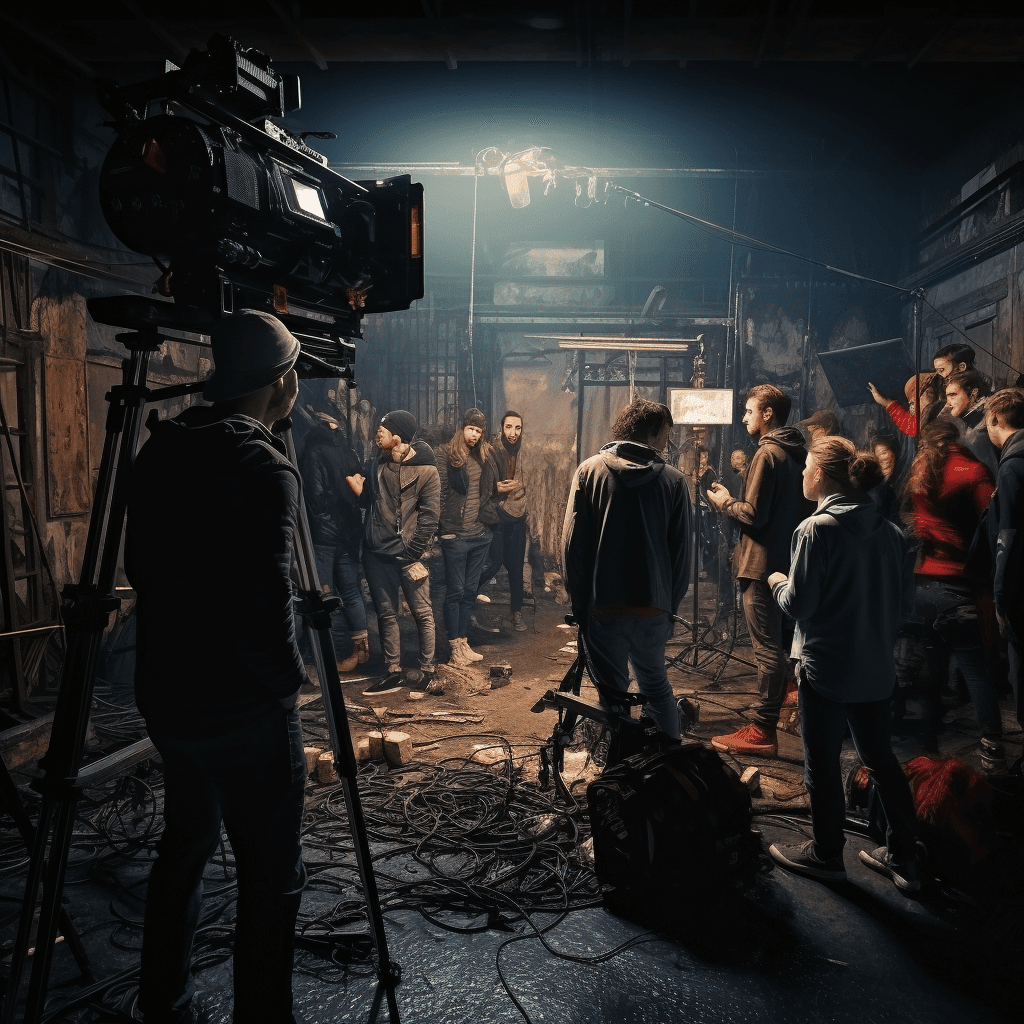
What's After the Blog?
History • Special Effects
The Evolution of Action Cinema: From Stunts to CGI
Explore the thrilling evolution of action cinema from the daring stunts of early films to the stunning CGI of modern blockbusters in our comprehensive blog post.
April 3, 2024

Movies mentioned in this article
The Evolution of Action Cinema: From Stunts to CGI
Introduction
Action cinema has consistently been a source of exhilarating entertainment, captivating audiences with its blend of high-octane sequences, awe-inspiring stunts, and groundbreaking technological advancements. From the early days of silent films to the modern era of digital effects, the evolution of action cinema offers a fascinating insight into the film industry’s capacity for innovation and spectacle. This post will journey through the landmark moments that have defined action cinema, spotlighting the iconic films and pioneering techniques that have left an indelible mark on this thrilling genre.
The allure of action cinema lies not just in its visual splendor but also in its ability to mirror the technological and cultural shifts of its times. In the early 20th century, the limitations of film technology meant that filmmakers had to rely on real-life stunts and practical effects, which in many ways laid the foundation for the genre. As technology advanced, so did the scope and scale of action films, leading to the integration of computer-generated imagery (CGI) and digital effects that have become staples in contemporary cinema. Through this evolution, action films have continuously pushed the boundaries of what’s possible on screen, offering audiences experiences that are as immersive as they are thrilling.
The Early Days of Action Cinema
The genesis of action cinema can be traced back to the early 1900s, a time when the film industry was still in its infancy and the concept of a ‘genre’ was yet to be established. During this period, filmmakers were experimenting with the new medium, exploring various ways to tell stories and engage audiences. It was in this era of experimentation that action cinema found its roots.
One of the earliest examples of action in film is the 1903 classic, The Great Train Robbery. Directed by Edwin S. Porter, this silent film is often credited with introducing many of the techniques that would become staples in action filmmaking, such as cross-cutting to build tension and using location shooting to add realism. The film’s iconic scene of a bandit shooting directly at the camera is a landmark moment in cinema history, showcasing the raw, untamed nature of early action scenes.
As the 20th century progressed, action cinema began to take a more defined shape. The 1920s and 30s saw the rise of swashbuckling adventures and heroic escapades, epitomized by actors like Douglas Fairbanks in The Mark of Zorro and Errol Flynn in the 1938 classic, The Adventures of Robin Hood. These films featured daring sword fights, dramatic chases, and a sense of adventure that captured the imagination of audiences worldwide. The use of real stunts, elaborate sets, and practical effects in these films laid the groundwork for the action genre, establishing a template that would be refined and expanded upon in the decades to come.
The action genre of this era was characterized by its reliance on physicality and practical effects. Stunts were performed by the actors themselves or by stunt doubles, adding an element of authenticity and danger to the films. The absence of CGI or advanced special effects meant that filmmakers had to be creative in their approach to action scenes, often using camera tricks, miniatures, and practical explosions to achieve the desired impact.
During this period, action cinema was not just about the spectacle of stunts and fights; it also reflected the societal values and attitudes of the time. The heroes of these early action films were often larger-than-life characters who embodied ideals of bravery, honor, and righteousness, resonating with audiences looking for escapism during the turbulent years of the early 20th century.
In summary, the early days of action cinema were marked by groundbreaking filmmaking techniques, daring stunts, and a sense of adventure that laid the foundation for the genre. As technology and storytelling evolved, so too would action cinema, leading to the golden age of stunts and the eventual integration of CGI, which we will explore in the following sections of this post.
The Golden Age of Stunts
The 1960s and 1970s marked what many consider the golden age of stunts in action cinema. This era brought forth an explosion of high-octane, stunt-driven films that pushed physical boundaries and set new standards for what action sequences could achieve. Movies from this period were characterized by their breathtaking, often death-defying stunts, many of which were performed without the safety measures or special effects that are common today.
One of the most iconic films of this era is Bullitt, released in 1968. The film’s legendary car chase through the streets of San Francisco, featuring Steve McQueen, is often cited as one of the greatest chase scenes in cinematic history. What made this scene so remarkable was the fact that McQueen, an accomplished driver, performed many of the stunts himself, adding an unparalleled level of authenticity and adrenaline to the sequence. The absence of CGI or advanced editing techniques meant that these stunts had to be executed flawlessly in real-time, a testament to the skill and bravery of the stunt performers of this era.
The 1970s continued to elevate the art of the stunt with films like Enter the Dragon (1973), which showcased Bruce Lee’s extraordinary martial arts skills. Lee’s ability to perform complex, highly choreographed fight sequences brought a new level of artistry to action cinema, influencing countless films that followed. His dedication to realism and physical prowess set a high bar for martial arts cinema and helped popularize the genre globally.
Another significant aspect of this era was the rise of the “disaster film” genre, exemplified by movies like The Towering Inferno (1974) and Earthquake (1974). These films relied heavily on practical effects and large-scale stunt work to create the illusion of massive catastrophes, captivating audiences with their scope and spectacle.
This period in cinema was not just about the stunts themselves, but also about the impact they had on audiences. The visceral thrill of watching real people perform dangerous feats on screen created a sense of immediacy and excitement that was hard to replicate. It was an era where the stunt performer became as crucial to the film’s success as the director or the lead actor, often risking their lives to bring these incredible sequences to life.
Rise of Special Effects and Practical Effects
As we transitioned into the late 1970s and 1980s, action cinema began to evolve with the introduction of advanced special effects and continued innovation in practical effects. This era marked a turning point, where the spectacle of action sequences was enhanced not just by the bravery of stunt performers, but also by the magic of visual effects.
The release of Star Wars in 1977 was a watershed moment for special effects in cinema. George Lucas’s space opera used groundbreaking visual effects to create its iconic space battles and alien worlds, transforming the landscape of action cinema. The use of models, matte paintings, and the revolutionary motion control photography brought a level of detail and realism to the screen that had never been seen before.
Following the success of Star Wars, other films began to incorporate more sophisticated special effects into their action sequences. Raiders of the Lost Ark (1981), directed by Steven Spielberg, combined thrilling stunt work with innovative special effects to create memorable action scenes, like the iconic boulder chase. This blend of practical stunts and visual effects would become a hallmark of action cinema in the 1980s, allowing filmmakers to create sequences that were both realistic and fantastical.
However, the use of special effects did not mean the end of practical effects. In fact, many films from this era are celebrated for their ingenious use of practical effects to achieve scenes that would have been impossible or too costly to film in real life. For example, The Thing (1982) by John Carpenter used groundbreaking practical effects to create its horrifying alien creature, demonstrating that practical effects could still play a vital role in action and horror cinema.
This era of action cinema showed that the combination of practical effects and emerging special effects technology could create new possibilities for storytelling. It allowed filmmakers to expand the scope of their action sequences, creating worlds and set pieces that were more elaborate and more immersive than ever before.
In the next sections, we will explore how the advent of CGI further revolutionized action cinema, blending with practical effects to create the modern action spectacle we know today.
The Digital Revolution: Introduction of CGI
The 1990s heralded a new era in action cinema with the introduction of Computer-Generated Imagery (CGI), fundamentally changing how action scenes were conceived and executed. This digital revolution allowed filmmakers to create visuals that were previously unimaginable, opening a realm of endless possibilities. The impact of CGI on action cinema was profound, offering a new dimension of creativity and spectacle.
One of the trailblazers in this domain was James Cameron’s Terminator 2: Judgment Day (1991). This film not only pushed the boundaries of narrative storytelling but also introduced groundbreaking CGI effects. The liquid metal T-1000 character was a feat of visual effects, showcasing the potential of CGI to create entirely new kinds of action sequences and characters. This marked a turning point, proving that CGI could be used not just for spectacle, but also to enhance the storytelling in action films.
The late 1990s saw the release of The Matrix (1999), a film that redefined the visual language of action cinema. Its innovative use of “bullet time” — a visual effect that slows down time during action sequences — became a cultural phenomenon. The Matrix combined traditional martial arts choreography with advanced CGI, creating a seamless blend that was both visually stunning and narratively engaging. This film demonstrated the potential of CGI to create a unique cinematic experience, influencing countless films in the following decades.
CGI also allowed for the creation of massive, intricate set pieces that would have been impossible to construct in reality. Films like Independence Day (1996) showcased large-scale destruction and alien invasions with an unprecedented level of detail and realism. The ability to digitally create entire cities and then visually destroy them changed the scale of action cinema, allowing for more grandiose and spectacular sequences.
However, the introduction of CGI also brought challenges. As filmmakers increasingly relied on digital effects, there was a risk of losing the physicality and realism that characterized earlier action films. The challenge for modern action cinema has been to find the right balance between digital spectacle and authentic, engaging action.
The Blend of Practical Effects and CGI
The 21st century saw a maturation in the use of CGI in action cinema, with filmmakers striving to strike a balance between digital effects and practical stunts. This blend aimed to harness the best of both worlds — the limitless possibilities of CGI and the tangible, visceral impact of practical effects.
Films like Mad Max: Fury Road (2015) exemplified this approach. Director George Miller used a combination of real stunts, practical effects, and CGI to create a post-apocalyptic world that felt both fantastical and utterly real. The film’s high-speed chases and explosive action sequences were grounded in physical stunts, with CGI used subtly to enhance the visuals, not dominate them. This approach earned widespread acclaim, showing that a harmonious blend of practical and digital effects could create an action experience that was both innovative and emotionally engaging.
The John Wick series, starting in 2014, is another excellent example of this trend. These films are known for their meticulously choreographed fight scenes, where the use of practical stunts and minimal CGI adds to the intensity and realism of the action. The series’ focus on hand-to-hand combat and practical effects is a nod to the action films of the past, while its stylish execution demonstrates the advancements in filmmaking techniques.
This blend of practical and digital effects has become the hallmark of modern action cinema. It allows filmmakers to create more complex and dynamic action sequences while maintaining a level of realism and physicality. This approach respects the legacy of traditional stunt work while embracing the innovations brought by digital technology.
In the next sections, we will delve into how CGI has influenced the authenticity of action scenes and look at the future of action cinema, exploring upcoming trends and potential advancements in technology.
How has the use of CGI affected the authenticity of action scenes in movies?
With the advent of CGI, a crucial question emerged in action cinema: How has the use of digital effects impacted the authenticity of action scenes? While CGI has enabled filmmakers to craft visually spectacular sequences, it has also sparked a debate about the balance between visual wizardry and the raw, tangible quality of traditional action scenes.
The primary concern among some critics and audiences is that over-reliance on CGI can lead to action scenes feeling less ‘real’. Unlike practical effects and stunts, which carry an inherent risk and physicality, CGI sequences are crafted in the digital realm, potentially leading to a detachment from the visceral thrill of real action. Films like Transformers series, known for their heavy CGI, often face criticism for creating action scenes that, while visually impressive, lack a sense of physicality and realism.
However, CGI has also been praised for its ability to expand the scope of storytelling and create action sequences that would be impossible or too dangerous to perform in reality. Movies like Avatar (2009) and Inception (2010) have used CGI not just as a tool for spectacle, but as a means to enhance the narrative and create unique visual experiences. In these films, CGI enables the depiction of fantastical worlds and mind-bending action sequences that contribute significantly to the story’s impact.
The key to maintaining authenticity in action scenes appears to lie in the judicious use of CGI, complementing rather than replacing practical effects. When used thoughtfully, CGI can elevate an action sequence, enhancing the realism and impact without overshadowing the physical elements of the scene.
The Future of Action Cinema
As we look towards the future, the evolution of action cinema shows no signs of slowing down. Advancements in technology and filmmaking techniques continue to push the boundaries of what’s possible in action sequences. The future of action cinema is likely to see further integration of cutting-edge technologies like virtual reality (VR), augmented reality (AR), and artificial intelligence (AI) in filmmaking.
VR and AR have the potential to create even more immersive action experiences, allowing audiences to feel as though they are part of the action. Films may start to include interactive elements, where viewers can experience action sequences from different perspectives, adding a new dimension to cinematic storytelling.
AI is also set to play a significant role in the future of action cinema. With advancements in machine learning and computer vision, AI could be used to choreograph complex action sequences, create realistic digital doubles of actors, or even generate entire action scenes. This technology holds the promise of creating action sequences that are more intricate and realistic than ever before.
Another trend that may shape the future of action cinema is the increasing emphasis on global and diverse storytelling. As the global film market continues to expand, action films are likely to feature a broader range of cultural perspectives and settings, reflecting a more diverse array of experiences and stories.
In conclusion, the evolution of action cinema from stunts to CGI is a testament to the film industry’s constant pursuit of innovation and spectacle. As technology continues to advance, action cinema will undoubtedly find new ways to thrill, surprise, and engage audiences, ensuring that the genre remains as dynamic and exciting as ever.
What are some must-watch action movies for fans of stunning visuals and groundbreaking effects?
For fans of action cinema, especially those enamored by stunning visuals and groundbreaking effects, there is a treasure trove of films that have pushed the boundaries of what’s possible on the big screen. These movies not only offer breathtaking spectacle but also showcase the incredible advancements in filmmaking technology over the years. Here is a curated list of must-watch action films that are a testament to the genre’s evolution:
- Mad Max: Fury Road: A visual masterpiece, this film combines practical effects with CGI to create a post-apocalyptic world that is both surreal and intensely real.
- Inception: Christopher Nolan’s mind-bending thriller uses innovative special effects to create a dream world where the impossible becomes possible.
- The Matrix: Known for its groundbreaking “bullet time” effect, this film blends martial arts with futuristic CGI, redefining action cinema.
- Avatar: James Cameron’s epic sci-fi adventure set a new standard for visual effects, creating an immersive alien world.
- Gravity: Alfonso Cuarón’s space thriller combines stunning visuals with a gripping narrative, pushing the limits of cinematic realism.
- Crouching Tiger, Hidden Dragon: This film brought wuxia to a global audience, blending traditional martial arts with ethereal, stylized action sequences.
- Terminator 2: Judgment Day: A landmark in CGI use, featuring a liquid metal antagonist that showcased the potential of digital effects in action cinema.
- The Lord of the Rings: The Return of the King: Epic in scale, this fantasy adventure combines practical and digital effects to bring a rich, fantastical world to life.
- John Wick: Known for its practical stunts and minimal CGI, this series revitalizes the action genre with its emphasis on close-quarters combat.
- Iron Man: This film kickstarted the Marvel Cinematic Universe and demonstrated how CGI could be used to create realistic and dynamic superhero action.
Each of these films represents a milestone in the evolution of action cinema, from practical stunts and effects to the seamless integration of CGI. They are not only visual spectacles but also stories that resonate with audiences, showcasing the power of action cinema to entertain, awe, and inspire.
Conclusion
The journey through the evolution of action cinema, from the daredevil stunts of the early 20th century to the digital wizardry of modern blockbusters, reflects the ever-changing landscape of filmmaking. This evolution is not just about technological advancements; it’s about the enduring appeal of action cinema to captivate and thrill audiences. The genre’s ability to adapt and innovate ensures that it remains at the forefront of cinematic entertainment, continually pushing the boundaries of what is possible on screen.
As we’ve explored, each era of action cinema has contributed its own unique elements, from the raw physicality of early stunt work to the sophisticated blend of practical effects and CGI in contemporary films. The future of action cinema looks bright, with emerging technologies promising even more immersive and spectacular cinematic experiences.
For movie enthusiasts and casual viewers alike, the action genre offers an exhilarating escape into worlds where the impossible becomes reality, where heroes defy odds, and where the thrill of the chase, the clash of battle, and the spectacle of explosion and adventure capture our imaginations. As we look forward to the next chapter in the evolution of action cinema, one thing is certain: the thrill, the excitement, and the awe of action movies will continue to captivate us for generations to come.
We invite you to continue exploring the world of movies with ATM, your go-to destination for movie information, including end credit scenes, actor details, and much more. Dive into our extensive database and discover the magic of cinema in all its forms.
Continue reading

What's After the Movie?
Not sure whether to stay after the credits? Find out!
Check out our other apps:
Actors
Companies
Latest Movies
© 2025 What's After the Movie. All rights reserved.

























